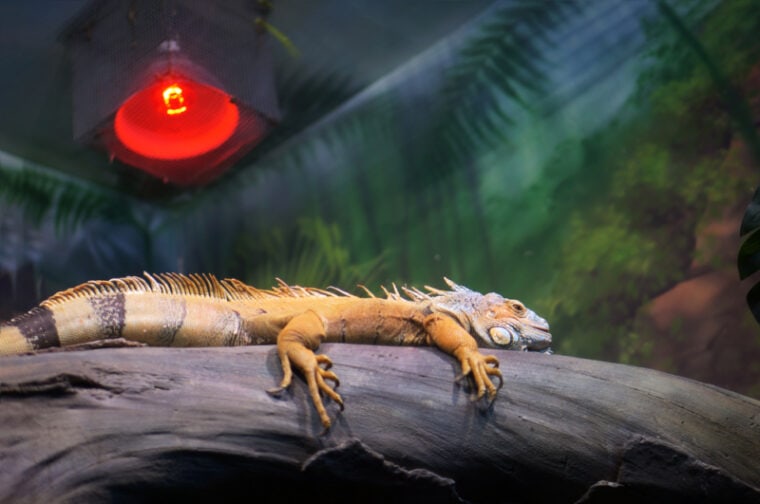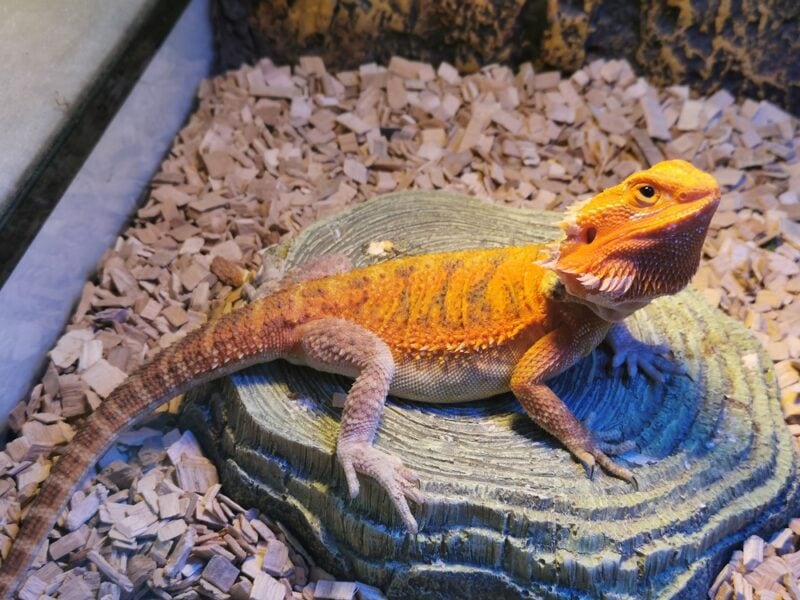
Click to Skip Ahead
Your captive reptile’s tank is their entire world. Since they aren’t able to keep their space clean, it’s up to you as the owner to get the job done right. Cleaning your reptile tank is a vital piece of husbandry and must be done regularly.
An unclean environment can lead to a slew of health issues and veterinary bills that are easily avoided. Like any other pet, reptiles can also transmit zoonotic disease, especially salmonella, so you want to keep up with cleaning to keep yourself and others safe, too. Keep reading to learn how to safely and effectively clean your reptile’s tank.
The 10 Steps to Clean Your Reptile’s Tank
1. Gather Your Supplies
When it’s time to clean your reptile tank the first thing you want to do is gather all the necessary supplies. Since there are quite a few things you need, it will be much more convenient for you if you have them all in one place and ready to go.
2. Remove Your Reptile
Once you have all your supplies set aside, it’s time to remove your reptile from its enclosure and place them in a secured temporary enclosure so it can comfortably wait out the process. You can use a backup tank, container, or box, just make sure it is secure enough that they can’t escape. The last thing you want to worry about is your reptile being on the loose.
We strongly recommend putting them in a separate room for their safety. Reptiles are very sensitive to any chemical fumes that are emitted by these cleaning products. It can lead to some severe respiratory issues and is very dangerous to their health. Keeping them far away from any cleaners will help ensure they remain as safe and healthy as possible.

3. Turn Off All Heating Sources and Remove Temperature / Humidity Monitors
Different reptiles have different heating and lighting requirements, so it won’t be the same for everyone. Since reptiles are cold-blooded, they regulate their body temperature through a process called thermoregulation.
In captivity, reptiles require external heat sources to keep them at the appropriate temperature within their habitat. This includes different types of lighting, under-tank heating mats, heating tape, and more. Heat and humidity are also monitored by a thermometer and hygrometer.
Once your reptile is safely inside its temporary enclosure, go ahead and turn off all sources of heat and place each item in a safe place until you are done. Also, remove the thermometer and/or hygrometer to keep them from being damaged as you clean. Some of these heat sources can get pretty hot, so make sure to use caution to prevent burning yourself.
4. Remove Accessories and Décor
Now it’s time to remove all accessories and tank décor. This includes hides, water bowls, plants, logs, and anything else that isn’t disposable. Since these items come in regular contact with your pet, place them in a bucket or a large bowl as they wait to be cleaned.
This is for sanitary reasons, as they could have remnants of feces or urate on them that you don’t want to come into contact with your regular surfaces. If you choose not to place them in a bucket, make sure you do not sit them in a sink that is close to where you prepare food or drinks.

5. Throw Out the Substrate
Once you have everything out of the tank, it’s time to throw out the substrate. Simply dump it into a nearby trash can and brush off any pieces of substrate that have stuck to the surface of the tank. If you have some stubborn pieces, use your gloved fingers or even a paper towel to remove them.
6. Clean the Tank
Using hot water and dish soap, scrub all the interior surfaces of the tank. This can be done with sponges or a paper towel. If there are any remnants of feces or urate stuck to the surface, you can use either a razor blade or putty knife to gently scrape it off. nUse an old toothbrush to reach any hard-to-reach areas like the corners and seams of the tank. Once the tank has been scrubbed thoroughly, rinse it with clean water.
Once cleaned off, you can disinfect using a 10% bleach solution, terrarium cleaner, or a white distilled vinegar solution. These products are used to kill any remaining bacteria that could be left over and leave the glass looking clear, crisp, and streak free.
Vinegar is less effective at disinfecting when compared to bleach, but it has been proven effective in killing salmonella, E. coli, and listeria monocytogenes, with salmonella being a concern for reptile owners. It’s a great, eco-friendly, safe option that many reptile keepers use. Bleach is also highly effective at disinfecting, but ensure you use the recommended dilution.
There are plenty of reptile-safe terrarium cleaners available on the market; not all are aimed at disinfecting but will effectively clean the tank. Do your research and read the reviews from other reptile parents if you choose to go this route.
Once you are finished disinfecting, you need to rinse thoroughly with hot water and as a general rule, rinse it again. You do not want any leftover disinfectant solution to remain in the tank when you put your pet back inside. Allow the tank to dry as you move on to cleaning the accessories.

7. Wash All Accessories and Décor
As the tank dries, take all of your accessories out and start cleaning them one by one with hot water, dish soap, and your sponge or paper towel. You may need to use that toothbrush to get into any small crevices for the most thorough cleaning.
If you want to disinfect these items, you can use your chosen solution to do so. Just make sure that you rinse thoroughly and rinse again to make sure all the solution has been removed.
8. Allow the Tank and Accessories to Dry
Once the tank and the accessories have been rinsed off, allow everything to dry. You can help speed along the process by using a towel, but make sure it won’t leave behind any residue or cause streaking on the glass.
You do not want any excess moisture from cleaning to remain in the tank or on the objects, as it could cause the humidity to increase inside the habitat and this could be harmful to species that require an arid environment.

9. Reconstruct the Habitat
Do a quick check all over the tank to ensure there are no cracks. Also, make sure there are no frayed or cracked wires on the heating sources, thermometer, and hygrometer before you set everything back up. Put in the fresh substrate and reconstruct their habitat as it was before you cleaned it, accessories, and all.
You will want to make sure all heating sources are plugged in and working properly. It can take a few minutes for the heating mats to warm back up, but you should be able to feel some warmth radiating off them pretty quickly. Refill the clean water bowl with some fresh, clean water, and the tank should be ready for its inhabitant.
10. Return Your Reptile and Give Them Privacy
Remove any gloves and don’t forget to wash your hands before handling your pet. Gently place your reptile back in its tidy home to let them readjust. It can be stressful for them when they are displaced momentarily.
Certain species or individuals may seem completely unbothered by the process, while others may come off as fearful or shy. We recommend giving them some privacy and quiet time to allow them to reacclimate, just in case. Put away all your supplies and wash your hands again for good measure!

The Importance of Cleaning Your Reptile’s Tank
While doing regular deep cleaning of the tank is very important, you should also keep up with daily maintenance to ensure your precious reptilian’s environment is as clean as possible. Not only will this help prevent the transmission of any zoonotic disease, but it will ensure they are healthy.
A clean, healthy living environment that is kept at the proper temperature and humidity is necessary for your reptile to thrive and live a long life. The husbandry requirements vary significantly among pet reptiles, so make sure you research your specific species to ensure you are providing the correct care.
An unclean tank can be a breeding ground for bacteria, mold, and other pathogens, which can be very harmful to both you and your reptile. They will be at risk for respiratory illness, skin issues, and premature death if they live in an unclean environment.
How Often Should I Thoroughly Clean the Tank?
Some pet reptiles are cleaner and easier to maintain than others, so the correct answer here can vary. Some reptiles will even burrow and leave waste buried in the substrate, so it’s important to clean the tank thoroughly and replace the substrate regularly to prevent waste buildup.
It is recommended that you do a thorough cleaning and also disinfect the enclosure once every two to three months or as needed. Keep a close eye on the tank’s cleanliness and use your best judgment. If you feel like it could need a deep clean sooner, there’s certainly no harm in doing so.

Regular Maintenance Tips for Keeping the Enclosure Clean Between Deep Cleanings
Deep cleaning is just one aspect of the tank’s upkeep. Here are some very important tips for frequent maintenance that will help keep your reptile’s enclosure as clean as possible in between those thorough cleanings.
Conclusion
Doing a thorough, deep clean on your reptile’s tank is an important part of their care routine. Regardless of which species of reptile you have, they need a clean and healthy environment to remain healthy and live their best life. It’s recommended that you are thoroughly cleaning and replacing the substrate at least once every two to three months. Depending on the species and their habits, you may need to do so more often. Don’t forget to keep up with regular maintenance to keep their habitat in good shape in the meantime.
Featured Image Credit: Marina Veder, Shutterstock







